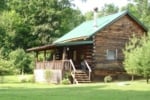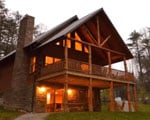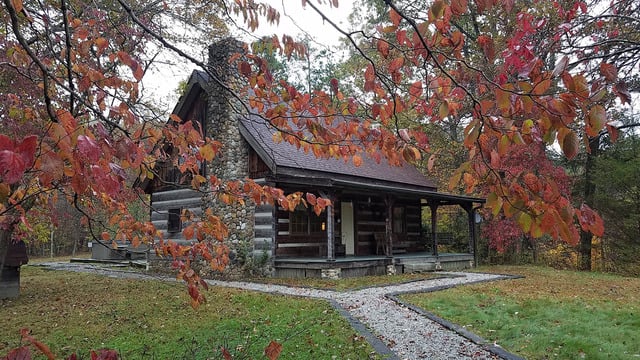WOLF RUN STATE PARK
The rugged hills of southeastern Ohio provide the setting for Wolf Run State Park. The scenic woodlands and cool, clean waters of the park offer visitors a quiet retreat in this remote area of the state.
Wolf Run State Park s nestled in the heart of the unglaciated Appalachian Plateau of southeastern Ohio. The hills in the park region remained untouched by the glacial advances that passed over much of the state more than 12,000 years ago.
Nevertheless, meltwaters from the vast sheets of ice helped to permanently alter the topography of the area. Stream flow was greatly increased, hastening the cutting of valleys and creating the rugged terrain so prevalent today. The predominant bedrock in the Wolf Run region is sandstone deposited during the Pennsylvanian period, with alternating layers of coal.
The Wolf Run area has been dramatically changed since the settlement of man. The original forests soon fell to the ax and were replaced with farms and villages. Fortunately, much of the forest has regrown and now covers 70 percent of the region. This second growth forest is mixed mesophytic, meaning that dominance is shared by a large number of tree species. White and red oak, tuliptree, sugar maple, beech, wild black cherry and white ash are frequent members of this forest type. Mixed mesophytic forests are renowned for their plant diversity including ferns, clubmosses, mosses, algae, fungi and lichens. These forests are in some ways the most ecologically exciting in the state. Deer, gray squirrels, raccoons, skunks, weasels, bats, black rat snakes, box turtles, wild turkey, ruffed grouse and great horned owls are among the many animals that make this area their home.
Wolf Run State Park is located near the town of Caldwell in Noble County, the last of the 88 counties formed within Ohio. In 1795, the Treaty of Greenville was signed ending the Indian threat in this part of Ohio paving the way for settlement. The first settlers to the area were New Englanders travelling by way of Marietta, Ohio up the valley of Duck Creek from the Ohio River into what is now Noble County.
Agriculture, livestock and profitable industries_born of the many mineral resources of the area_provided a living for the settlers. Coal, iron ore, building stone, petroleum and salt were plentiful. Oil was accidently discovered near Caldwell in 1814 when Robert McKee began drilling a well to obtain brine. At the depth of 475 feet, a crevice was struck containing oil. At first considered a nuisance, the true value of the oil was eventually realized and derricks soon lined the valley of Duck Creek. Oil prices declined drastically during the Civil War bringing an end to major drilling efforts in the area.
Land acquisition for the park began in 1963. Construction of the dam and spillway for the lake was complete in 1966 as part of the West Fork Duck Creek Watershed Project. The 1,338-acre facility including the 220-acre lake was officially dedicated as a state park in 1968. The park received its name from the Wolf family, the first to settle in the area.
Ohio does not have an annual pass and does not charge entrance fees to state parks.
GeneralLand, acres1,046
Water, acres220
Day-UseFishingyes
Huntingyes
Hiking Trail, miles6
Picnickingyes
Picnic Shelters, #1
Swimming Beach, feet200
BoatingBoating Limits10
Seasonal Dock Rental19
Launch Ramps, #1
CampingPrimitive, #67
Electric Sites, #71
Pets Permittedyes
Dumpstationyes
Showersyes
Youth Group Camp, capacity150
WinterSleddingyes
Cross-Country Skiingyes
Fly-In Campsites, #20
A family campground with 138 non-electric sites is located on the south shore of the lake. Showers and laundry facilities are provided. A walk-in group area with fire rings is available for use by organized youth groups on a reservation basis.
A 20-site primitive fly-in camping area is located on the north side of the lake. The area is within walking distance of the 4,700-foot runway at the Noble County Airport. Picnic tables, fire rings and latrines are provided.

Cottages and Cabins
Situated at the heart of Salt Fork Lake, our cabins all offer privacy and seclusion,with hot tubs, decks, grills, private bonfire pits and beautiful rock wood burning fireplaces. All cabins are extremely clean, well furnished and equipped. Wonderful for all occasions. Hunters are welcome at our cabins
18.6 miles from park*
A public swimming beach is located on the south side of the lake and provides restrooms and changing booths. The beach is open during daylight hours only.
Scuba diving is also permitted in the lake, except within the beach area. Proper equipment and marking of the diving area are required. Diving alone is prohibited.
Boats with motors of up to 10 horsepower are permitted on Wolf Run Lake. A launching ramp and tie-ups are available on the south side of the lake, easily accessible from State Route 215.
Wolf Run State Park in Ohio offers a variety of fishing options for both experienced and novice anglers. The park's main attraction is the 220-acre Wolf Run Lake, where you can fish from either the shore or a boat. Species that populate this lake include largemouth bass, bluegill, crappie, channel catfish and saugeye. Fishing boats are available to rent within the park if needed.





